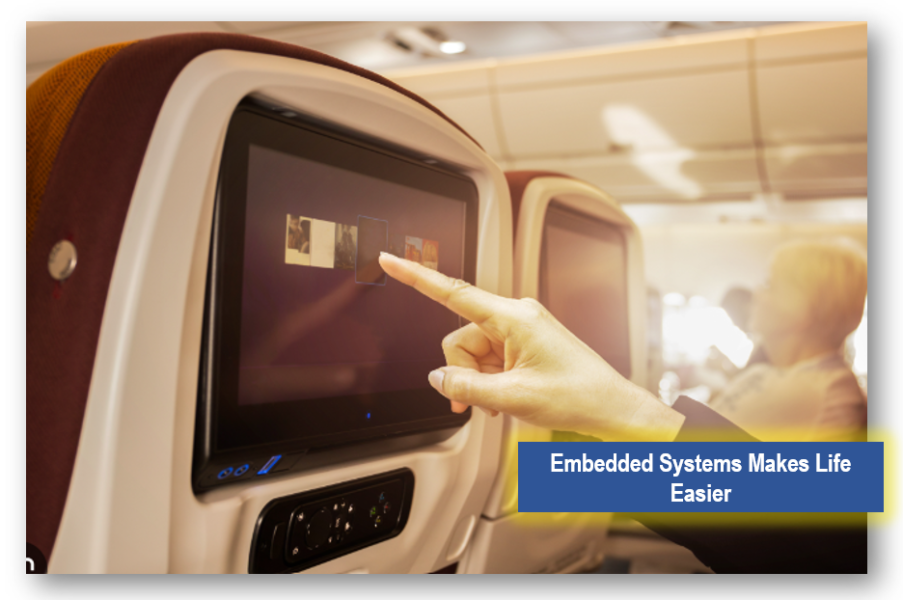Embedded System Engineer possesses expertise in embedded systems programming (Embedded systems programming is the creation of software for specialized computer systems that are embedded within a larger device), hardware interfacing, and real-time operating systems. In an Aerospace and Defence Manufacturing Company, they play a crucial role in designing, developing, and testing embedded systems for aircraft, spacecraft, and defense systems.

Their primary responsibilities encompass:
Embedded System Design and Development: Embedded engineers collaborate with design teams to conceptualize, design, and develop embedded systems that meet specific functional and performance requirements of the stringent Defence Industry. They consider factors such as processing power, memory requirements, real-time constraints, and environmental conditions to ensure the system’s suitability for its intended application.
Hardware Interfacing and Communication: Embedded engineers design and implement hardware interfaces to connect embedded systems to sensors, actuators, and other external devices. They implement communication protocols to enable data exchange between the embedded system and other systems within the overall system architecture.
Real-Time Programming and Embedded Software Development: Embedded engineers develop embedded software using specialized programming languages and techniques, such as C/C++, assembly language, and real-time operating systems (RTOS). They write code to control the behaviour of the embedded system, managing tasks, processing sensor data, and generating control signals.
Testing and Debugging: Embedded engineers conduct thorough testing and debugging to ensure the embedded software functions correctly and meets all performance and reliability requirements. They employ various testing methodologies, including unit testing, integration testing, and system testing.
Integration and Validation: Embedded engineers integrate the embedded system with other components of the overall system, ensuring seamless operation and adherence to performance specifications. They perform validation testing to verify the system’s functionality in real-world scenarios.
Documentation and Communication: Embedded engineers maintain detailed documentation of the embedded system design, software code, and testing procedures. They effectively communicate technical information to stakeholders, including system designers, hardware engineers, and software testers.
Continuous Improvement and Innovation: Embedded engineers stay abreast of advancements in embedded hardware, software tools, and programming techniques. They actively participate in research and development initiatives to introduce innovative solutions that enhance the performance, efficiency, and reliability of embedded systems.
Key Responsibilities:
Creating process plans for the fabrication, assembly, and testing of aerospace and defence components and systems.
Compliance with Standards and Regulations: Embedded engineers ensure that embedded systems comply with relevant industry standards, regulations, and safety codes. They stay informed about changes in standards and implement necessary updates to maintain compliance.
Troubleshooting and Problem-Solving: Embedded engineers investigate system malfunctions or anomalies to determine root causes. They employ analytical tools and experimental methods to diagnose problems, such as software bugs, hardware failures, or communication issues.
Technical Support and Maintenance: Embedded engineers provide technical support to system users and maintainers, resolving issues related to embedded software functionality and hardware interfacing. They may also be involved in the development and implementation of software patches and updates.
Cybersecurity Considerations: Embedded engineers incorporate cybersecurity measures into the design and implementation of embedded systems to protect against cyberattacks and unauthorized access. They may utilize encryption techniques, access control mechanisms, and secure communication protocols.
Overall, Embedded Engineers play a critical role in the aerospace and defense industries, enabling the development of sophisticated embedded systems that are essential for real-time control, data acquisition, and decision-making in aircraft, spacecraft, and defense systems. Their expertise and innovation are crucial for the advancement of these technologies and the success of critical missions.
Companies an Embedded Engineer can work for in the Defence Industry:
All manufacturing companies have openings for project managers / engineers. Companies which manufacture, fighter aircrafts such as Tejas, Rafale, helicopters Prachand, Apache, tanks like Arjun.
Boeing (India)
Airbus (India)
Basic Qualifications:
Electrical and Computer Engineering (ECE): This degree provides a strong foundation in both electrical engineering and computer science, which are essential for embedded systems development. Students will learn about electronics, circuits, microprocessors, programming languages, and operating systems.
Computer Science (CS): This degree focuses on the theoretical and practical aspects of computing. Students will learn about algorithms, data structures, programming languages, computer architecture, and operating systems. While a CS degree may not cover all of the specific topics needed for embedded systems programming, it will provide a strong foundation in the underlying principles.
Computer Engineering: This degree combines elements of electrical engineering and computer science to focus on the design and development of computer systems. Students will learn about electronics, circuits, microprocessors, programming languages, computer architecture, and operating systems.
Software Expertise:
There is no job today which does not need software expertise. In the domains of Aerospace and Defence, an Embedded Systems Engineer is concerned with creating systems programming which invariably interface with a larger system.
Unique features of the Job
- Highly Technical
- Highly Taxing also
- Excellent programming skills
- High Paying also!

